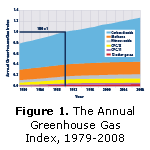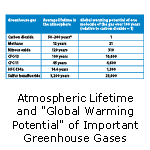Climate Change
Climate Change Indicators in the United States

This figure shows the amount of radiative forcing caused by various greenhouse gases, based on the concentrations present in the Earth's atmosphere. Radiative forcing is represented by the Annual Greenhouse Gas Index, which is set to a value of 1 for 1990.
Data source: NOAA, 2009 1

Several factors determine how strongly a particular greenhouse gas will affect the Earth's climate. One factor is the length of time that the gas remains in the atmosphere. For example, a molecule of methane emitted today will last an average of 12 years before decaying, while a molecule of sulfur hexafluoride will last for thousands of years. Each gas also has its own unique ability to absorb energy and contribute to climate forcing. By considering both the lifetime of the gas and its ability to absorb energy, scientists have come up with an overall global warming potential for each gas, which is expressed relative to the global warming potential of carbon dioxide.
* Carbon dioxide's lifetime is poorly defined because the gas is not destroyed over time, but instead moves between different parts of the ocean–atmosphere–land system. Some of the excess carbon dioxide will be absorbed quickly (for example, by the ocean surface), but some will remain in the atmosphere for thousands of years.
Data source: EPA uses atmospheric lifetimes and global warming potentials from the Intergovernmental Panel on Climate Change's (IPCC's) Second Assessment Report, 2 as countries have agreed to do under current international treaties within the United Nations Framework Convention on Climate Change (UNFCCC). Two exceptions are CFC-11 and CFC-12, which are not covered under the UNFCCC and for which EPA is using values from the IPCC's Third Assessment Report. 3
Key Points
- In 2008, the Annual Greenhouse Gas Index was 1.26, an increase in radiative forcing of 26 percent over 1990 (see Figure 1). Carbon dioxide accounts for approximately 80 percent of this increase.
- Of the five most prevalent greenhouse gases shown in Figure 1, carbon dioxide and nitrous oxide are the only two whose contributions to radiative forcing continue to increase at a steady rate. By 2008, radiative forcing due to carbon dioxide was 35 percent higher than in 1990.
- Although the overall Annual Greenhouse Gas Index continues to grow, the rate of increase has slowed somewhat over time. This change has occurred in large part because methane concentrations have remained relatively steady since 1990, and CFC concentrations are declining because most of their uses have been banned (see Figure 1).
Background
When energy from the sun reaches the Earth, the planet absorbs some of this energy and radiates the rest back to space as heat. The Earth's surface temperature depends on this balance between incoming and outgoing energy. If this energy balance is shifted, the Earth's surface could become noticeably warmer or cooler, leading to a variety of changes in global climate.
A number of natural and man-made mechanisms can affect the global energy balance and force changes in the Earth's climate. Greenhouse gases are one such mechanism. Greenhouse gases in the atmosphere absorb and re-emit some of the outgoing energy radiated from the Earth's surface, causing that heat to be retained in the lower atmosphere. Some greenhouse gases remain in the atmosphere for decades or even centuries, and therefore can affect the Earth's energy balance over a long time period. Factors that influence Earth's energy balance can be quantified in terms of "radiative climate forcing." Positive radiative forcing indicates warming (for example, by increasing incoming energy or decreasing the amount of energy that escapes to space), while negative forcing is associated with cooling.
About the Indicator
The Annual Greenhouse Gas Index measures the average total radiative forcing of 17 greenhouse gases, including carbon dioxide, methane, and nitrous oxide. This index was calculated by the National Oceanic and Atmospheric Administration based on measured concentrations of the gases in the atmosphere. Because each gas has a different capacity to absorb heat energy, this indicator converts concentrations into a measure of the total radiative forcing (energy absorption) caused by each gas.
The total radiative forcing of these gases is then translated into one index value. This value represents the ratio of the total radiative forcing for that year compared with the total radiative forcing in 1990.
Indicator Confidence
There are uncertainties and limitations in the data and models used for deriving radiative forcing values. In addition, the Annual Greenhouse Gas Index does not consider certain other climate forcing mechanisms. For example, reflective aerosol particles in the atmosphere can reduce radiative forcing, while ground-level ozone can increase it.
Data Sources
Data for this indicator were provided by the National Oceanic and Atmospheric Administration. This figure and other information are available at: www.esrl.noaa.gov/gmd/aggi.
Indicator Documentation
- Download related technical information PDF (5 pp, 37K)




